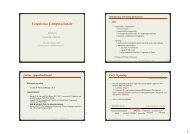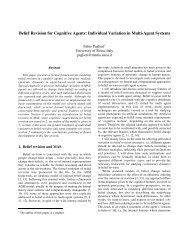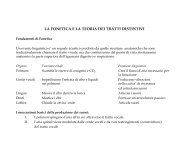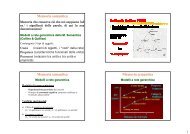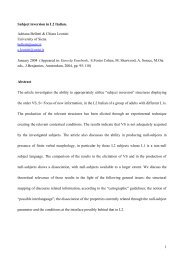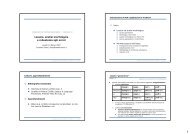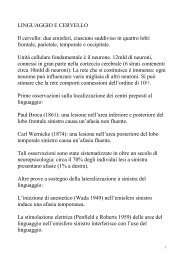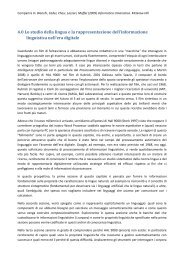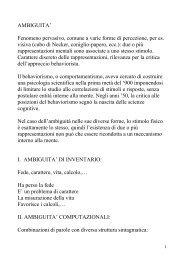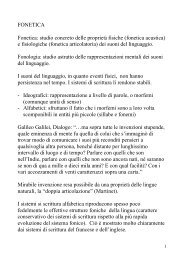Verbal morphology in Greek: the 'passive'
Verbal morphology in Greek: the 'passive'
Verbal morphology in Greek: the 'passive'
You also want an ePaper? Increase the reach of your titles
YUMPU automatically turns print PDFs into web optimized ePapers that Google loves.
(i)<br />
(ii)<br />
(iii)<br />
Passive: John is be<strong>in</strong>g/was pricked (by <strong>the</strong> doctor).<br />
Reflexive: John is prick<strong>in</strong>g/pricked himself.<br />
Anticausative: John is be<strong>in</strong>g/was pricked (accidentally) with <strong>the</strong> needle.<br />
All NACT morphologies (specialized <strong>in</strong>flection and th-formations) give rise to all read<strong>in</strong>gs;<br />
[See also Manney 2000, Tsimpli 2005, 2006, Alexiadou & Anagnostopoulou 2004].<br />
III. The pattern and <strong>the</strong> questions that arise<br />
Specialized agreement vs. active agreement with th-.<br />
The split is regulated by aspect (perfective).<br />
What are <strong>the</strong> properties of th- and specialized agreement, such that <strong>the</strong> presence of <strong>the</strong><br />
former excludes <strong>the</strong> latter and vice versa? (cf. *di-th-ome).<br />
How do <strong>the</strong>se morphological realizations correlate with syntax?<br />
How do <strong>the</strong>se morphologies correlate with <strong>the</strong> English passive affix –en (if <strong>the</strong>y do)?<br />
3. The empirical evidence II: Albanian (Standard and dialects)<br />
I. Morphology<br />
Data from Gjirokastër (a Tosk variety, essentially <strong>the</strong> Standard) and from Shkodër (a Geg<br />
variety) [IPA transcription used] – (h)= <strong>the</strong> NACT affix. 2<br />
Present imperfective<br />
(13) Gjirokastër<br />
a. la- (h)- m/ / t/ mi/ ni/ n<br />
wash NACT 1sg 2sg 3sg 1pl 2pl 3pl<br />
„I am be<strong>in</strong>g washed‟ etc.<br />
b. la- i/ n/ n/ im/ ni/ <strong>in</strong><br />
wash 1sg 2sg 3sg 1pl 2pl 3pl<br />
„I wash (someth<strong>in</strong>g)‟ etc.<br />
a‟. vi- (h)- m/ / t/ mi/ ni/ n<br />
dress NACT 1sg 2sg 3sg 1pl 2pl 3pl<br />
„I am be<strong>in</strong>g dressed‟ etc.<br />
b‟. v -/ -/ -/ im/ ni/ <strong>in</strong><br />
dress 1sg 2sg 3sg 1pl 2pl 3pl<br />
„I dress (somebody)‟ etc.<br />
(14) Shkodër<br />
a. l- - m/ / t/ na/ ni/ n<br />
wash NACT 1sg 2sg 3sg 1pl 2pl 3pl<br />
„I am be<strong>in</strong>g washed‟ etc.<br />
b. l- i/ n/ n/ im/ ni/ <strong>in</strong><br />
wash 1sg 2sg 3sg 1pl 2pl 3pl<br />
„I wash (someth<strong>in</strong>g)‟ etc.<br />
a‟. ve- - m/ / t/ na/ ni/ n<br />
dress NACT 1sg 2sg 3sg 1pl 2pl 3pl<br />
„I am be<strong>in</strong>g dressed‟ etc.<br />
2 For more data see Manz<strong>in</strong>i & Savoia (2008).<br />
4




